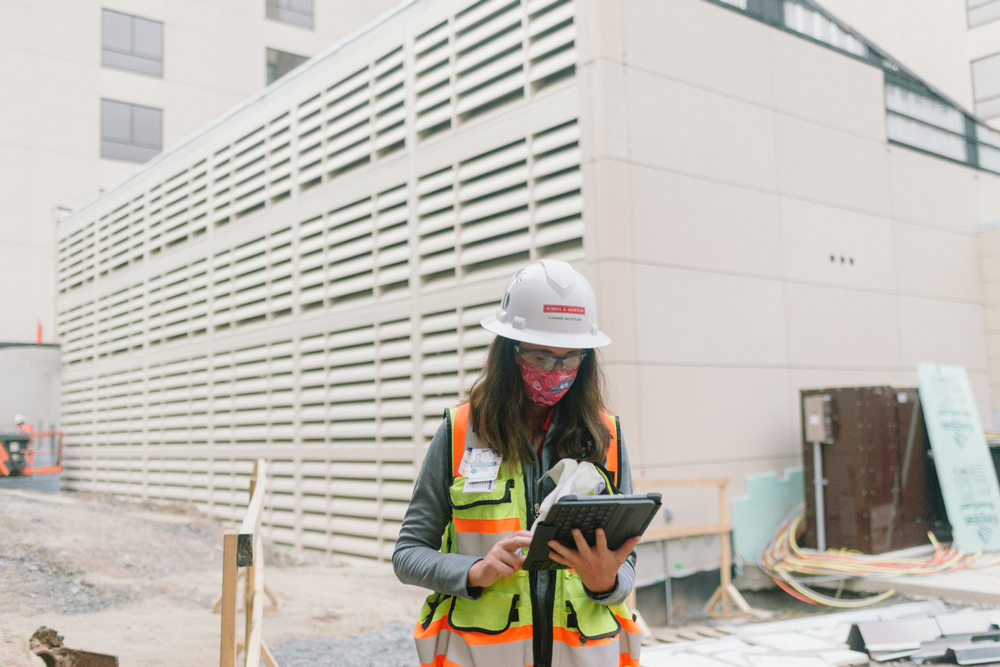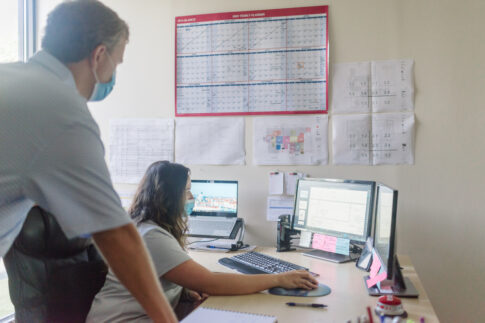
By Rachael Farr
At the onset of 2020, construction firms felt optimistic for the year ahead.
Demand for construction was high, and industry challenges seemed predictable. Construction leaders were confident, until COVID-19 spread across the nation.
While “pandemic” may have been Miriam-Webster’s 2020 Word of the Year, it was “flexibility” for construction teams. In many ways, the pandemic changed building by accelerating innovation, requiring a greater reliance on technology and adding a new dimension to workplace safety.
General contracting and construction management firm Robins & Morton was among the many companies that had to quickly develop procedures and protocols in response to changes in everything from the workplace to supply chain issues. In a roundtable discussion with a few of the company’s field leaders, they summarized what the year taught them.
- Lessons learned will be the new estimating frontier. Although cost-per-square-foot has been an industry best practice to predict cost, it hasn’t been able to withstand the impacts of the pandemic. From temperature-checking equipment to deep cleaning, each action, product and consultation contributed to changes in operating cost. Although there have always been unknowns, construction is attuned to short-term events, such as inclement weather. The pandemic introduced a new obstacle: predicting cost for events that are both unforeseen and long term. Robins & Morton Superintendent Josh Young said that in the future we may begin seeing line items in an estimate solely dedicated to sustained disasters, such as a pandemic.
“As a construction manager, it’s up to us to provide a safe and healthy work environment and that’s going to cost money,” Young said. “We need to be ready for it.”
However, it’s not an easy tangible. Robins & Morton Senior Preconstruction Manager Scott Bullock equated the challenge to “trying to count the sprays [of disinfectant] needed,” and then explained that something like this would also depend on cost trends for a project’s size, workforce and location.
“Lessons learned are going to be the new estimating frontier,” Robins & Morton Senior Mechanical Preconstruction Manager Kyle Davis, said. “The question now is how do we prepare for, and navigate, that?”
So far, the answers for Young, Bullock and Davis reinforce that data and shared information is key. In the coming year, they predict an increased emphasis on turning qualitative lessons learned into quantitative cost estimates.
- Demand for futureproofing will increase. There’s been a surge in low-voltage infrastructure work in recent years, due in no small part to the boom in technology. From the latest in artificial intelligence to smart devices, every part of a building’s visitor experience is now connected.
Whether a hotel or a hospital, all features must have the necessary infrastructure to support them. For design and construction teams, their work often includes preparing facilities for technology that doesn’t yet exist. The unique challenges presented during the pandemic underscored the need for future flexibility and upgraded low-voltage infrastructure, including the growing use of telehealth and demand for tech-enabled isolation space.
“As we’re building or renovating facilities, they need to be able to accommodate the increasing amount of change to the IT makeup of a campus in the coming years,” Davis said. “We’re not building for five or even 10 years here; this is long-term planning in an era where technology changes tremendously in the short term.”
Moving into 2021, futureproofing – especially when it comes to technology – will remain a critical point of evaluation in design, engineering and construction.
- Those involved in the construction and design process will take a closer look at prefabrication processes. Finding the best ways to leverage prefabrication and modularization have been an attractive topic in recent years. However, in 2020, prefabrication became more than the future of efficient construction – it was identified as a potential path for reducing the potential of virus spread. Utilizing prefabrication, which is often conducted in a warehouse, not only provides greater opportunities to socially distance, but also reduces the necessary workforce to install it, further limiting large gatherings onsite.
In many ways, this echoes prefabrication’s impact on the construction industry’s existing workforce challenges. In the same way it supports social distancing and limiting workforce onsite, it serves as a solution to maintain schedules as construction needs outpace its workforce.
However, Davis believes the industry has stalled in leveraging prefabrication’s value until fundamental pieces of the construction and design process change.
“We need to begin designing for prefabrication to be able to save the most money and onsite workforce, while impacting the schedule positively. This is something contractors can help with if we’re brought in early,” Davis said. “Some of our clients are moving in this direction because they see the value, but it really goes against tradition of starting design before even hiring a contractor. Until we break through that, we’ll continue to keep implementing prefabrication in a piecemeal way and not realizing its full potential.”
- Relationships among contractor, client and architect are much closer. In a year where the very foundations of design are being revisited, clients were – and continue to be – faced with a series of never-ending decisions regarding the future planning of their facilities. As a result, many are relying heavily on their design and construction teams to navigate the implications of the new normal. Specifically, for healthcare clients, this may be campus master planning, determining the best utilization of bed capacity, anticipating supply chain challenges or coordinating items with long lead times for future projects.
One such example was the award of a future substation project. At the time, the client was not quite ready to begin, however Superintendent Mike Dare carefully reviewed lead times for the project’s key elements to uncover that it would take the substations approximately 42 weeks to arrive. Dare’s team presented a plan and recommendation to proceed with ordering the substations to assure a timely delivery for beginning.
“They issued us pre-purchasing specs for equipment before we even designed the project so we could go ahead and get it ordered,” Dare said. “We’re focusing on getting this major component first and then designing the rest of the project around it. We’re changing how we’re looking at master planning and projects.”
Looking beyond immediate construction needs and working closely together will be practices that outlast the pandemic as new issues face business owners and facility operators.
- There’s a growing comfort with using technology in official capacities. Although 2020 will be the year of mastering videoconference applications for personal and in-office use, the pandemic’s lengthy duration also led to a digital transition for the official duties of authorities having jurisdiction. To support social distancing, many jobsites hosted virtual visits and inspections as the projects progressed.
 “[AHJs] have digitized a lot of the procedures to keep pace with the times,” Dare said. “I would have never thought that we’d one day be doing FaceTime inspections.”
“[AHJs] have digitized a lot of the procedures to keep pace with the times,” Dare said. “I would have never thought that we’d one day be doing FaceTime inspections.”
Director of Corporate and Operational Technology David Pratt said that he’s also seen an increase in requests for field technology tools such as 360 degree cameras to limit travel among engineering and architecture teams. He said that those involved in the construction process are growing comfortable with using tech in place of in-person review meetings.
Young mentioned that his project realized substantial cost savings by eliminating monthly, in-person meetings with the client, design team and contracting team by moving them to a virtual environment.
“Think about it,” Young said. “You eliminate travel cost for 10 to 15 people every month.”
The growing comfort with the virtual environment ushers in a new era of realizing cost efficiency and further blurs geographic boundaries. However, there is still value in in-person interactions, and the coming years will provide a clearer rubric for the savviest way to allocate funds accordingly.
Although the world seemed to stand still in 2020, construction work forged ahead. Faced with finding a new way to build amid pandemic challenges, the industry changed. As with most change, much of its impact altered longstanding processes and protocols – many that found a permanent place in the foreseeable future.
Rachael Farr is communications manager for general contractor Robins & Morton. She can be reached at rfarr@robinsmorton.com.


 Join our thriving community of 70,000+ superintendents and trade professionals on LinkedIn!
Join our thriving community of 70,000+ superintendents and trade professionals on LinkedIn! Search our job board for your next opportunity, or post an opening within your company.
Search our job board for your next opportunity, or post an opening within your company. Subscribe to our monthly
Construction Superintendent eNewsletter and stay current.
Subscribe to our monthly
Construction Superintendent eNewsletter and stay current.